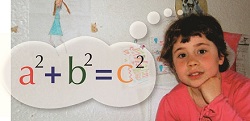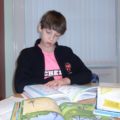Any child is a mathematician
Is problem solving possible at the age of seven?
 When I opened my son’s school report several years ago and read that ‘Nicolas’s Problem Solving, Reasoning and Numeracy skills are weak and below his peers’, I realised that my son needed some extra help. I then started to teach Nicolas maths at home, typically for one or two hours per week. The exercises for that came from maths books based on the method developed for primary school children by maths educator and psychologist Vasily Davydov. Davydov’s method is based on the finding that around the age of seven children develop an ability to think in abstract terms, and that cognitive development occurs when children are confronted with a problem that can only be solved with a technique not yet known to them. Thus, in Davydov’s method children are constantly challenged, but in a way that is appropriate to their age. An American study has shown that children taught by Davydov’s method are able, by the age of ten, to solve maths problems not normally encountered until secondary school.
When I opened my son’s school report several years ago and read that ‘Nicolas’s Problem Solving, Reasoning and Numeracy skills are weak and below his peers’, I realised that my son needed some extra help. I then started to teach Nicolas maths at home, typically for one or two hours per week. The exercises for that came from maths books based on the method developed for primary school children by maths educator and psychologist Vasily Davydov. Davydov’s method is based on the finding that around the age of seven children develop an ability to think in abstract terms, and that cognitive development occurs when children are confronted with a problem that can only be solved with a technique not yet known to them. Thus, in Davydov’s method children are constantly challenged, but in a way that is appropriate to their age. An American study has shown that children taught by Davydov’s method are able, by the age of ten, to solve maths problems not normally encountered until secondary school.
Davydov’s method has certainly worked well for Nicolas. He achieved Level 3a in maths at the end of Year 3 and Level 4b at the end of Year 4. After a few years of our maths lessons my eldest child is viewed as a ‘maths prodigy’ by his peers and teachers. In reality, he simply has a solid foundation which enables him to tackle ‘tricky’ questions correctly. My second child, who has been doing maths with me for about a year, is described as a ‘natural mathematician’. I do not necessarily see my children as future mathematicians, they love reading and are fascinated by history and one day might choose to study humanities. The important thing is that they both learned to enjoy maths, it feeds their natural curiosity, it gives them confidence and, I believe, will expand their choices in the future.
Here are some examples of exercises from our textbooks:
- Exercise for children aged seven
- Make up a story problem based on the equation: x + 23 = 61
- Exercise for children aged ten
- Write down the mathematical model and find all the possible solutions for this problem:
Natasha writes down a two digit number. When she reverses the digits and subtracts the new number from the original number the answer she gets is 45. What is her original number?’
Are you intrigued, interested, curious? Would you like your children to enjoy maths and be able to use it in the future whether they choose to be academics or business people? I believe that the foundations are laid in primary school. Later may be too late.








This link could be of interest:
3-1=2
It is a list of 20 arithmetic problems, each as simple as an arithmetic problems could be — because each of them can be solved by the same arithmetic action 3 – 1 = 2.
The puzzle that I have to solve for submitting this post is four + [ ] = 8 and involves a harder arithmetic action. But 20 problems represent something that is not properly taught in schools in this country: recognition that arithmetic is a science about the world around us.
Thank you Alexandre,
Beautiful word problems. My son is sitting 11 plus exams this autumn and I found your problems very helpful for his maths practice.
Pingback: Time for “serious” maths | Mums & Dads